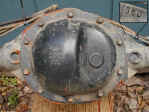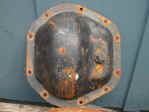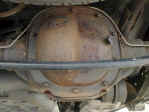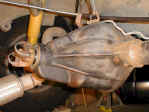


Cherokee XJ Dana 44 Rear Axle
The first step of my Phase II modifications was to find a new and stronger rear axle. The "weakest link" on my XJ is the rear Dana 35 axle, followed closely by the NP231 output shaft. Like many upgrades, this one begs the question, "Is there anything else that should be done while I'm at it?" You may have little money or a lot of money to spend on your Jeep, but either way, you'll end up spending less in the long run with a solid plan for the future. Set a goal and shoot for it. You'll spend less time and less money than you would replacing things over and over again. In my case, a rear axle upgrade snowballed into a major drivetrain rework. More on that later. First, I needed to figure out which axle to choose.
Picking the Right Axle
There are some popular upgrades and a couple of lesser-known axles to replace the original Dana 35. All have pluses and minuses. Of all the choices, there are two stand-outs: the Dana 44, especially an original XJ axle, and the Ford 8.8" axle from a '95-'01 Explorer. These two give you more strength, ease of installation, and a stock 5 on 4.5" bolt pattern.
Dana 35 vs. Dana 44
Why another axle? As I continue to participate in more and more 4x4 events, the stock Dana 35c rear axle has become a worry point. I like to joke that I hang out with "the wrong crowd" and that they're always getting me into trouble. The truth is that my friends are into some pretty hard-core 'wheeling and I go where they lead... often into some very tough terrain. The Dana 35 has the reputation of being weak, and that's true for a few reasons. The axle shafts and gears are small, yes, but more of a problem is the axle housing. The center casting of a Dana 35 is smaller than a Dana 44 casting, and the Dana 35 axle tubes are also smaller. The weaker casting and tubes allow the whole assembly to flex, causing the axles, gears, and even carriers to break more easily. My Dana 35 had already broken once, and I had no desire for it to break again. Fortunately, I had the proper parts and tools to repair the axle, but the time spent and the potential for similar future breakage had me looking for more strength.
By measure, my complete Dana 44 axle is over 30% heavier than my Dana 35... 230 lbs. vs. 175 lbs. XJ Dana 44 axle tubes measure 2.76" in diameter, necking down just a tad to 2.72" at the center differential housing. The XJ Dana 35 axle measures 2.64" in diameter, necking down quite a bit to 2.48" at the diff.
Cherokee XJ Dana 44
 The
Dana 44 axle is an extremely popular upgrade for small to mid-sized Jeeps and other 4x4s.
Did you know, however, that all Dana 44 rear axles are not the same? The Dana 44 has been
used in lots of vehicles, including Jeep, Dodge, Scout and Isuzu, so naturally there are
differences in various axles you'll find. Among the possible differences you'll find in
Dana 44 axles are: different bolt patterns, drum vs. disc brakes, axle width, spring perch
type and location, and axle tube diameter and thickness, centered or offset (a little or a
lot) differentials, and cast steel or aluminum housings.
The
Dana 44 axle is an extremely popular upgrade for small to mid-sized Jeeps and other 4x4s.
Did you know, however, that all Dana 44 rear axles are not the same? The Dana 44 has been
used in lots of vehicles, including Jeep, Dodge, Scout and Isuzu, so naturally there are
differences in various axles you'll find. Among the possible differences you'll find in
Dana 44 axles are: different bolt patterns, drum vs. disc brakes, axle width, spring perch
type and location, and axle tube diameter and thickness, centered or offset (a little or a
lot) differentials, and cast steel or aluminum housings.
The best axle to swap into a Cherokee XJ is the one that originally came with the XJ. Best because it's the easiest. Some earlier Cherokees with the Tow Package had the 44 underneath. (If you're still shopping for a Cherokee, spend a little more time and find one with the Dana 44 already there!) This axle is a direct replacement for the stock axle, with no relocation of spring perches or shock mounts necessary. Jeff's research says the Dana 44 was available (but rare) from '87 to '90 in the XJ.
The original XJ 44 can be bolted on to any Cherokee, with a possible modification only to the rear driveshaft. It's a length issue. The Dana 44 pinion is about an inch longer than the Dana 35 pinion, so technically you'll need a driveshaft that's an inch shorter. In my case, my earlier suspension lift offset the extra inch of pinion, so the new axle truely bolted in. Unless you're looking for extreme, Dana 60-class strength, the Cherokee 44 really is the best upgrade for the Jeep.
Other Dana 44s
A Dana 44 from any other vehicle will require some fabrication, like spring and shock perch relocation. The Jeep Comanche pickup (MJ) also came with an optional Dana 44 axle from '87 to '90, and is probably the second best choice for a swap. It's the correct width and bolt pattern. The Comanche axle was a spring-under design, however, so to use the MJ axle under an XJ the perches would have to be relocated to the XJ spring-over configuration. For other axle sources, small differences in width can be ignored (with luck) or solved with custom-offset wheels. Larger width differences (full-size truck axles) are prepared by disassembling, shortening, and rewelding the axle tubes to the differential housing.
Dana 44s are available from Scouts and the full-size (Grand) Wagoneers, although the wheel lug patterns are not the same as the XJ. The axle shafts would have to be redrilled, if possible, to the 5 on 4.5" pattern, or new shafts would be bought. The oddest 44 came (comes!) with the Grand Cherokee (ZJ and WJ) and has an aluminum housing. Yikes! Stay away from this one. It's fine for the street, but you'll run into a dead end trying to upgrade it.
A popular option for the new Jeep Wrangler (the TJ... the one with the coil-spring suspension) is the Dana 44 rear axle. Fantastic? Maybe. The TJ uses the same axles (same Superior part number) as the XJ axle. Ron and Vance agree, however, that the TJ uses the same axle tubes in both the standard Dana 35 and the optional Dana 44. If true, the factory Dana 44 option for the TJ is not as strong as older 44s.
I'm barely scratching the surface on Dana 44 information. See Terry Howe's JeepTech.com for more information.
Two great axles from Ford
The Ford 9" and Ford 8.8" axles are popular choices, too. The venerable Ford 9" has been around for decades, and, like the Dana 44, it comes in many flavors. It's primary features are the strong nine inch ring gear, a very low pinion, and removable-third-member design. Again, there are many variations of this axle, so do your research before buying. Some 70s Ford sedans had 28-spline Ford 9" axles with disc brakes and 5 on 4.5" pattern. A popular after-market variation on the Ford 9" is the Currie High Pinion (CHP) third member. Currie creates a great axle using the strongest housings and their own high pinion third member. The CHP gives up some strength because of its use of the Ford 8.8" gear set (instead of the standard 9" gears) but it's still strong and the pinion is way up and out of the way. The CHP isn't as important for us XJers with our long wheel base and shallow drive line angles, but it's still cool. Expensive, but cool.
The Ford 8.8" might be a better choice. It's probably the second-best option for a Cherokee upgrade, next to the XJ 44. Predictably, this axle has an 8.8" ring gear (compared to the Dana 44's 8.5" ring gear). The 8.8" axle comes in the Ford Explorer, so it's available and cheap. It's about the right width (~1.25" narrower), and has disc brakes. An important feature of the Explorer 8.8" axle is the 5 on 4.5" bolt pattern, which will match your Jeep's pattern. At least one company (M.O.R.E.) is making a weld-on conversion kit for the 8.8" axle ('95 through '01), so some of the guess work is eliminated.
A possible negative to the 8.8" is its c-clip axle design, which means (like the Dana 35) that the axle is held in place by c-clips at the differential, not by an outer axle flange. If your axle breaks, your wheel will come off! The Dana 44, in contrast, does not use a c-clip, so you're not completely stuck by a broken axle, but it's not a full-floating axle, either. A semi-floating axle, like the 44, can be driven a little way if broken, but not far. If there's a chance you'll break an axle, no matter which design, you should carry spares.
Isuzu Corporate 12-bolt?
Is the Isuzu Corporate 12-bolt axle worth a look? Yes. It's strange choice, but a strong one. To give you a clue about it's strength, Isuzu fans were angered when the factory "downgraded" newer Isuzus to the Dana 44 axle! The 12-bolt in one '90 Amigo has a width of 59" from wheel-mounting-surface to wheel-mounting-surface. That's about and inch or so more narrow than a stock XJ, so not too bad. It's leaf sprung and has disc brakes. Very cool. According to Randii (4x4Wire.com Chief and Master of All Things Mongrel), those Amigo specs should hold for all Isuzus with rear disc brakes made between 1988.5 and 1995. The later 12-bolt axles in Troopers should be wider, but I don't have numbers. The Troopers use a 4-link, coil spring setup. The downside to the Isuzu Amigo axle is the 6 on 5.5" bolt pattern. If you choose this axle, you'll want to convert either the front (a Wagoneer 44 would do it) or the rear to make the wheel bolt pattern the same.
Decision Time
After eye-popping, brain-melting amounts of research, I still can't make up my mind. At one time or another, each one of the above-named axles was a strong contender. At this moment the Ford 8.8" sounds pretty good... no... the 12-bolt. I don't know! I would probably still be scratching my head, except that someone posted a Dana 44 for sale out of an '88 Cherokee. 500 bucks and bolt-on easy. I bought it.
Before installation, I had a lot of work to do on the axle. I had to install a locker, gears, and fix the brakes. These jobs will be the subject of future articles.
| Axle | Axle Thickness |
Spline Count |
Bolt Pattern |
C-clip? | Ring Gear Diameter |
| Dana 35 (XJ) | ? | ? | 5 x 4.5" | most | ? |
| Dana 44 (XJ) | 1.31" | 30 | 5 x 4.5" | no | 8.5" |
| Ford 8.8" (Explorer) | 1.32" | 31 | 5 x 4.5" | c-clip | 8.8" |
| Ford 9" (some) | 1.33" | 31 | 5 x 4.5" | no | 9" |
| Isuzu 12-bolt | 1.32" | 26 | 6 x 5.5" | ? | ? |
| There are exceptions to these figures. Look before you leap. Some data from ARB. |
|||||
Weights:
Dana 35, complete w/ ARB Locker and brake drums: 175 pounds
Dana 44, complete w/ Ox Locker and brake drums: 230 pounds
Tube Thickness:
Dana 35, 2.64" dia. (2.48" at the diff)
Dana 44, 2.76" dia. (2.72" at the diff)
Jeff Yokomura's YJ Dana 44 conversion (using an XJ axle).